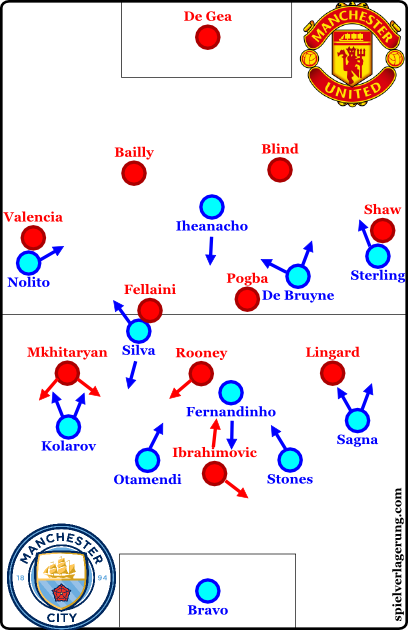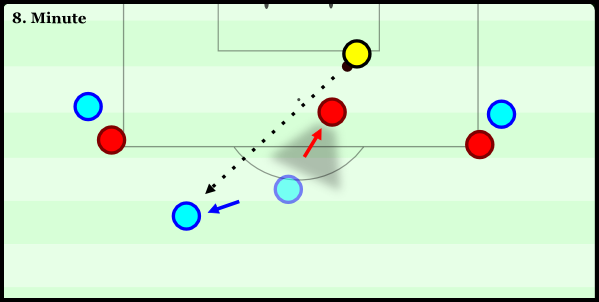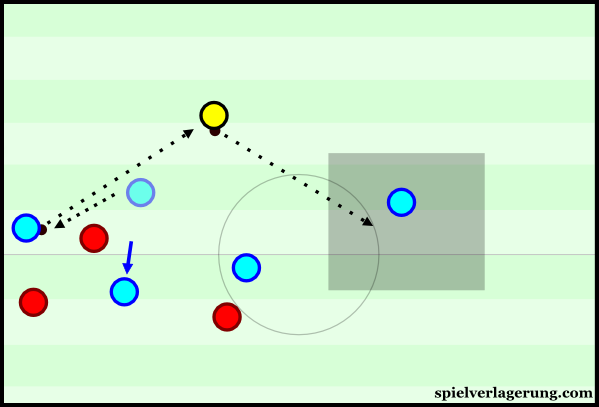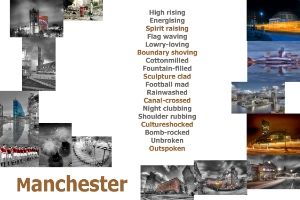this is an extract from a very interesting link in another thread, which I think is worth pasting here and goes to the heart of the debate as to whether Bravo is an upgrade if Hart had been perservered with and coached as a sweeper keeper. My view is it would have been a gamble and Pep didn't have the time or the cover to go down that route. There may well be a trade off in traditional keeper skills but Bravo is going to offer more important tactical opportunities.
http://spielverlagerung.com/2016/09/11/ ... -trafford/ City’s stable build-up & use of Bravo
One of the main reasons for City’s dominance was down to their ability to build-up in a stable fashion from deep areas. They demonstrated strong collective press resistance and their use of Bravo was a major factor behind this.
In deep build-up situations the use of Bravo as an additional defender allowed them to create an instant free man against United’s man-orientations. By doing this they were able to draw United’s forwards into pressing him in turn creating a free man in the defence or midfield line. This often allowed them to escape the first line of United’s pressing but there was a deeper and more subtle aspect that allowed them to do this.

When United’s forwards left their direct opponent to press Bravo they would often do so from an angle that allowed them to cover passes into said opponent whilst creating access to Bravo. In reaction to this City used blind side movement to escape the cover shadow of United’s presser in front. With this movement they could create passing options from situations where United appeared to have good access.
Furthermore this blind side movement was effective due to the positioning of the players ahead. Knowing that they were in control of the positioning of United’s midfield pair, Silva and De Bruyne used their positioning well to manipulate United’s pressing structure.
When they were able to use their blind side movement to create passing options in the first line Silva and De Bruyne would occupy higher positions which removed Pogba and Fellaini’s capacity to support the press. With weak support from behind United’s forwards were easily taken out of the game and City enjoyed large space behind United’s front line.

citys-blind-side-movement
Bravo as a free man and Fernandinho’s blind side movement.
However when United appeared to have good coverage of the passing options in the first two lines Silva would often drop and the reaction of Fellaini would have big implications for the actions of City’s ball carrier.
If Silva was followed into deep positions City could play longer towards the forwards to target a defence exposed without the support of the midfield line. This would give the forwards the chance to attack the back line directly if they could control the destiny of the second balls.
Alternately if he was not followed Silva would be able to act as a free man and allow City to break past United’s pressing structure.
Another area of their build-up that Bravo had a strong influence on was in connecting their possession from wide areas back into the centre. When City appeared to be trapped on the wings without viable passing options they used Bravo as a route to switch the ball back to the opposite half space.
In order to maintain coverage of the nearby passing options; United in particular the front two, had to shift over to the ball. In these situations City used Bravo to switch the ball to a centre back in the opposite half space. Due to the long distances they had to make up United could not create access against these half space switches and the recipient could drive forwards aggressively into midfield.
This would have a similar effect as the use of Bravo. United’s midfielders were put in situations where they were required to create access to the ball in front of them but also maintain coverage of their direct opponents behind them. At times they did neither and in moving forwards to press they only opened large spaces for their direct opponent to receive passes behind them.
City’s rotating back 3
In order to make these switches and connect their possession from wide areas back into the half spaces, Fernandinho and the centre backs demonstrated strong staggering. In these situations where the ball was seemingly trapped on the flanks Fernandinho often moved higher into midfield. This was done to drag Rooney forwards with him and reduce United’s presence in the front line which would in turn give the centre backs more time and space on the ball.
However this movement was at times done by the centre backs. In some situations the ball-near centre back would pass out to the full back and move forwards, if Ibrahimovic chose to follow then the pass back into Bravo was open. If he did not follow then City would be able to connect their play back into the centre through the ball-near centre back.

bravo-connecting-wide-possession
These simple movements were done with the intentions of maximising the potential passing options for each receiver which was particularly important to prevent them being trapped in wide areas. With Stones, Fernandinho and Otamendi making slight movements to occupy different positions and Bravo in deeper areas offering an easy route to make switches, City were able to make connections when they seemed to be trapped. This was particularly important and advantageous against a United defence that struggled to create access upon these switches, particularly in the half spaces.











